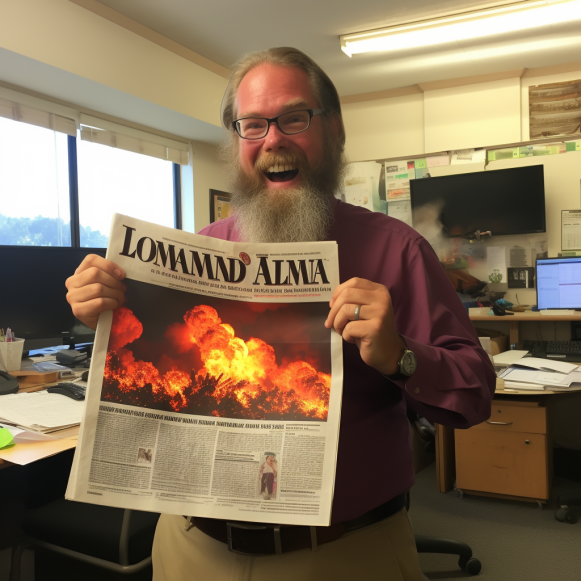Meet the volcano scientist protecting us from the next California eruption

Volcanoes might not be the biggest worry on Californians’ minds. But they’ve erupted before, and will again.
The next major quake. Fire dangers. Steph Curry broke both ankles at the same time. California certainly has its share of potential disasters, but one that you might not think of is volcanoes.
Give Andy Calvert a few minutes, and he might be able to change that. Calvert is the chief scientist at the California Volcano Observatory in Menlo Park as well as Moffett Field, a US Geological Survey facility that studies local volcanoes. They do exist: The eruption of Lassen Peak in the early 1900s devastated the surrounding region and spread ash all the way to Nevada. Eruptions near Mono Lake and Mammoth Mountain occurred relatively recently, between 300 and 600 years ago, and Mount Shasta erupted about 3,000 years ago and is capable of reoccurring.
“All of these volcanoes will erupt once more.” “Whether it will happen in our lifetimes or not is unknown,” says Calvert. “It’s not something that all Californians should be concerned about, but it’s significant enough to fund scientists to keep an eye on.” We’ll keep an eye on it, so you don’t have to.”
Calvert found time at the observatory, in between collecting samples, setting up ground instruments, and torturing rocks with high heat and pressure in a magma-dynamics lab, to talk about the explosive forces lurking beneath our feet.
Q: How did you get into this line of work?
A: I grew up in a small town in Idaho called Moscow. When Mount St. Helens erupted in 1980, we were hundreds of miles away. When I was in seventh grade, an inch of ash fell on my front porch, and school was canceled for the rest of the year. So, as I like to say, I’m repaying the earth for allowing me to skip seventh grade.
That ash from my front porch was the first rock sample I ever collected. I still have it on my desk; it’s a fine gray powder, similar to flour. That eruption was really what taught me that the earth is a dynamic place, and it was fascinating to study because it isn’t just a static backdrop.
Q: The Washington eruption cost more than $1 billion in damages. Would the economic cost of a California eruption today be comparable?
A: I believe a billion dollars is a very conservative estimate. Volcanoes, for the most part, aren’t exactly where people are. They, like Mount Shasta, are scattered on the outskirts of major civilization. However, they are located near freeways and towns. And when they erupt, they make quite a commotion. Mount St. Helens produced approximately 1 cubic kilometer of material, which is still being dealt with.
Q: Where are the volcanic hotspots in California?
Q: How frequently does an eruption occur in California?
A: It doesn’t work like a clock. These are separate systems that operate on their own time scales. However, we’ve had about ten significant eruptions in the last thousand years, so one every 100 years or so.
Q: Where will the next one be held?
A: What about the next one? Oh, here we go again. I believe it will be one of two locations: somewhere near the Lassen volcanic field or, more likely, near Mono Lake in the US 395 corridor. There are a few new, explosive Mono craters. That eruption would most likely last between one and six months, with some explosive periods spewing a lot of ash into the air. We’d have to route planes around it.
Q: Will this have a large impact on the ground?
A: Well, Lee Vining is right next to Mono Lake, and Mammoth Lakes is about 7,000 people year round, but on a busy day, there could be 25,000 people skiing. In fact, there was considerable concern in the 1980s about an eruption in Long Valley, near Mammoth Lakes. There was enough ground deformation that people became concerned, and housing prices fell. But nothing happened, and the magma remained in the ground – what we call a “failed eruption.”
Q: What immediate effects can we expect if a volcano erupts tomorrow?
A: Let’s say we choose Mount Shasta. If it actually blows tomorrow, it would have told us about it over the last two months or so. We would have felt earthquakes and seen ground deformation because we monitor by satellite and have GPS instruments on the ground. We would have contacted CAL OES, the Forest Service, and local sheriffs to devise a plan to move people out of the way.
Q: That’s important, but it’s not very enticing. Can we talk about the chaos?
A: A typical Mount Shasta eruption would most likely begin near the summit. Rising magma would heat the groundwater, causing explosions of old rocks, and the eruption would produce a large ash plume. Mount Shasta has a lot of ice, so if lava got close to it, it would melt catastrophically, causing large mudflows that would wreak havoc on roads and railroads.
Q: What about railroads?
A: Railroads run right along the edge of Mount Shasta, and a lot of freight passes through. The lowlands would be inundated, and the highway and railroad trestles would almost certainly be destroyed. A lot of the hydroelectric power we use in California comes from Oregon and Washington. Those high-voltage lines that run through Mount Shasta and Medicine Lake. Then there are the natural gas pipelines, which cross our Northern California volcanoes as well. As a result, there is a real possibility that much of our infrastructure will be impacted.
Q: Why should we be concerned about power lines?
A: When you put ash in humid air, it produces rain that looks like mud falling from the sky. This will adhere to the insulators, causing them to arc and short. This has actually occurred in other countries.
Q: Has anyone ever run scenarios for a volcanic eruption and a major earthquake hitting California at the same time?
A: Yes, we do discuss cascading events.
Q: Are you sure?
A: The likelihood of a large volcanic eruption and a significant earthquake occurring in the same location is very low. But it would be a huge undertaking. The important thing is to listen to authorities and evacuate when necessary. Just like with earthquakes or floods, you should have a plan in place, as well as some food and water, to deal with natural disasters, because they will occur.






